- Details
For 20 years the Lake of the Woods Water Sustainability Foundation has brought together citizens, dozens of municipalities and Indigenous nations and state, provincial and federal governments in Canada and the USA to amass the scientific, technical and community knowledge needed to inform an international water quality plan while building the trust and capacity to implement it.
With the arrival of the new year, the Lake of the Woods Water Sustainability Foundation has some important announcements to share in our endeavour.
- Details
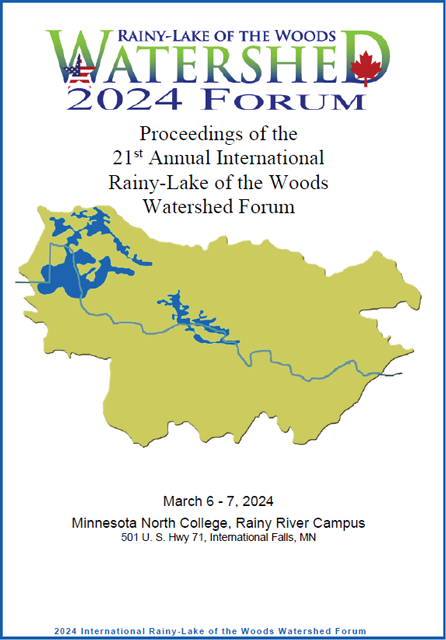 The Proceedings Report of the 2024 International Rainy-Lake of the Woods Watershed Forum is available for download at the Foundation’s website: lowwsf.com/forum-proceedings. Held March 6-7 in International Falls Minnesota, 142 researchers, resource managers, policy makers, and members of the public put Lake of the Woods and its watershed under the microscope.
The Proceedings Report of the 2024 International Rainy-Lake of the Woods Watershed Forum is available for download at the Foundation’s website: lowwsf.com/forum-proceedings. Held March 6-7 in International Falls Minnesota, 142 researchers, resource managers, policy makers, and members of the public put Lake of the Woods and its watershed under the microscope.
The Forum featured a moderated panel discussion on "From Science to Action" and 26 presentations in themes of: watershed governance, ecosystem modeling, contaminants and mining, ecological interactions, nutrient dynamics as drivers of cyanobacteria and cyanotoxin production, nutrient and sediment load tracing, and updates on the major monitoring programs of the MPCA and ECCC.
Fred Desjarlait, spiritual advisor from Miskwaagamiiwi – Zaagaiganing (Red Lake Nation), joined by Métis Senator Karen Cederwall, helped open the Forum, followed by addresses from Terry Duguid, Parliamentary Secretary and Special Advisor on Water to the Prime Minister and by US Consul Marilyn Gayton.
- Details
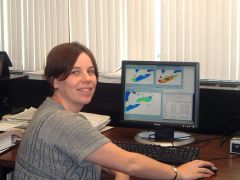 Dr. Caren Binding, research scientist in aquatic optics and remote sensing at Environment and Climate Change Canada, is the 2024 recipient of the Larry Kallemeyn Award. The Lake of the Woods Water Sustainability Foundation presented the award on behalf of the community of scientists and resource managers from the United States and Canada working in our watershed.
Dr. Caren Binding, research scientist in aquatic optics and remote sensing at Environment and Climate Change Canada, is the 2024 recipient of the Larry Kallemeyn Award. The Lake of the Woods Water Sustainability Foundation presented the award on behalf of the community of scientists and resource managers from the United States and Canada working in our watershed.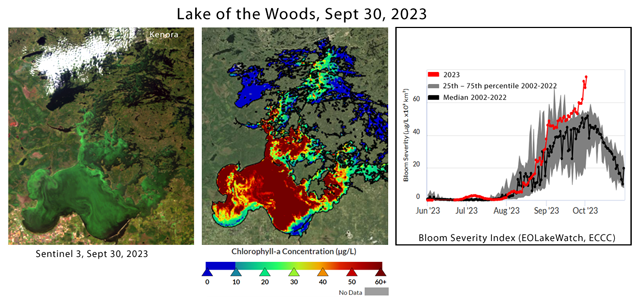 Massive algae bloom covers nearly 70% of Lake of the Woods, September 30, 2023. Panels (left to right) show sentinel satellite image, derived chlorophyll-a, and derived annual Bloom Severity index, Environment and Climate Change Canada (2023). EOLakeWatch 2023 Algal Bloom Report - Lake of the WoodsThe Kallemeyn Award recognizes Dr. Bindings outstanding scientific contributions to the watershed, including leading her team that developed the EOLakeWatch tool that uses satellite imagery to track algae blooms in Lake of the Woods (and other "Great Lakes") and derives indices of bloom extent, intensity and severity that will likely be foundational to long term monitoring for progress assessment as plans are implemented to cut phosphorus loads to the lake.
Massive algae bloom covers nearly 70% of Lake of the Woods, September 30, 2023. Panels (left to right) show sentinel satellite image, derived chlorophyll-a, and derived annual Bloom Severity index, Environment and Climate Change Canada (2023). EOLakeWatch 2023 Algal Bloom Report - Lake of the WoodsThe Kallemeyn Award recognizes Dr. Bindings outstanding scientific contributions to the watershed, including leading her team that developed the EOLakeWatch tool that uses satellite imagery to track algae blooms in Lake of the Woods (and other "Great Lakes") and derives indices of bloom extent, intensity and severity that will likely be foundational to long term monitoring for progress assessment as plans are implemented to cut phosphorus loads to the lake.
A heartfelt thanks and congratulations to Caren from the Foundation and the researchers gathered at the Forum for a well-deserved accolade!
- Details
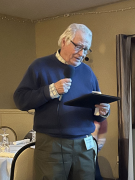 Paul Anderson is the 2024 recipient of the Gerry Wilson Stewardship Award. Paul was honored with this international award in recognition of his lifetime of environmental advocacy work on behalf of the Rainy Lake Conservancy, Voyageurs National Park and Voyageurs Conservancy and his service on the Community Advisory Group of the IJC International Rainy-Lake of the Woods Watershed Board.
Paul Anderson is the 2024 recipient of the Gerry Wilson Stewardship Award. Paul was honored with this international award in recognition of his lifetime of environmental advocacy work on behalf of the Rainy Lake Conservancy, Voyageurs National Park and Voyageurs Conservancy and his service on the Community Advisory Group of the IJC International Rainy-Lake of the Woods Watershed Board.
The Lake of the Woods Water Sustainability Foundation presented the award to Paul on behalf of the community of scientists, resource managers and water stewards from the United States and Canada at the 2024 International Rainy-Lake of the Woods Watershed Forum in International Falls, Minnesota.
Paul personifies the best of citizen engagement in conservation and protection. A life-long lover of Rainy Lake and the Rainy Lake watershed, Paul has been an active leader and contributor to initiatives to protect the watershed, including participating in oversight of hydropower and mining projects, advocating for emergency preparedness and response planning, reviewing the past two State of the Basin Reports, and advocating for improved land use and development planning.
Congratulations to Paul on this well-deserved recognition of his volunteer contributions to our waters!
The Foundation presents the Wilson Stewardship Award annually to recognize individuals, groups, or projects that are making significant contributions to environmental stewardship in the Rainy-Lake of the Woods watershed. For more information about the Wilson Stewardship Award see: www.lowwsf.com/wilson-award.
- Details
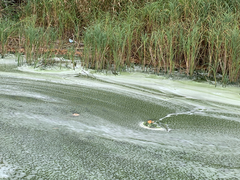 The view from space is compelling and confirms what we have seen firsthand on Lake of the Woods at the end of September. The cyanobacterial bloom (aka blue-green algae) on Lake of the Woods is tracking towards being one of the most severe since 2002.
The view from space is compelling and confirms what we have seen firsthand on Lake of the Woods at the end of September. The cyanobacterial bloom (aka blue-green algae) on Lake of the Woods is tracking towards being one of the most severe since 2002.
By late September, a massive bloom extended across 2,800 km2 or 73% of the lake’s surface. The bloom was extremely intense with satellite-derived measures of chlorophyll-a concentrations exceeding 60 µg/L over most of the southern and middle basins of the lake.
- Details
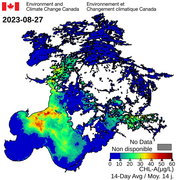 After a hot June but cool and sometimes smoky July, the algae bloom on Lake of the Woods started to develop in late July and early August as usual. Blooms began in the southern Big Traverse Bay and in the Morson-Sabaskong area to the south-east. By late August, the bloom covered 34% of the lake and has progressed northward through middle channel to Oak Point. Satellite-derrived measures of chlorophyll-a (a pigment in the algae) ranged above 40 µg/L (red in the satellite image) indicating severe bloom formation in a few locations (anything above 10 µg/L is considered a bloom).
After a hot June but cool and sometimes smoky July, the algae bloom on Lake of the Woods started to develop in late July and early August as usual. Blooms began in the southern Big Traverse Bay and in the Morson-Sabaskong area to the south-east. By late August, the bloom covered 34% of the lake and has progressed northward through middle channel to Oak Point. Satellite-derrived measures of chlorophyll-a (a pigment in the algae) ranged above 40 µg/L (red in the satellite image) indicating severe bloom formation in a few locations (anything above 10 µg/L is considered a bloom).
Algal blooms in Lake of the Woods typically peak in the late fall, and progress into the north-central area of the lake. Thus, more extensive blooms are expected to come later, expanding in extent and severity into the fall. Last year, peak severity occurred on October 13, 2022. We’ll have a complete report on the annual bloom conditions later in the fall, once the satellite tracking is complete for the season.
- Details
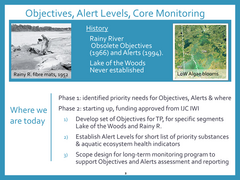 The Lake of the Woods Water Sustainability Foundation plays an essential role in coordinating the network of resource management agencies, government partners, and civil society contributors to watershed science and governance. This year, our coordination has been instrumental in driving forward the second phase of a project to develop recommendations for international water quality Objectives and Alert Levels for the Rainy-Lake of the Woods Watershed. The International Joint Commission has oversight responsibilities for water quality in our watershed, so this project will be administered by the IJC watershed board’s Aquatic Ecosystem Health (AEH) Committee, which is co-chaired by the Foundation Executive Director, Todd Sellers.
The Lake of the Woods Water Sustainability Foundation plays an essential role in coordinating the network of resource management agencies, government partners, and civil society contributors to watershed science and governance. This year, our coordination has been instrumental in driving forward the second phase of a project to develop recommendations for international water quality Objectives and Alert Levels for the Rainy-Lake of the Woods Watershed. The International Joint Commission has oversight responsibilities for water quality in our watershed, so this project will be administered by the IJC watershed board’s Aquatic Ecosystem Health (AEH) Committee, which is co-chaired by the Foundation Executive Director, Todd Sellers.
Objectives are international standards agreed to by Canadian and U.S. governments for boundary waters. Alert Levels are IJC watershed board-adopted trigger thresholds for advising the IJC and governments of issues of potential concern, where there are no international Objectives established.
- Details
Join us for the 2023 series of free “Ask An Expert” webinars, as we study our watershed and learn how to protect our natural resource assets. Our lineup of experts have a wealth of knowledge and this is your chance to connect directly with them.
Seminars will consist of an expert presentations followed by a Q&A opportunity. Pre-registration is required. More details and registration for the seminars at the links below.
May 15 @ 1:00 p.m. CDT: "Who's Who in the Watershed" - Megan Garner (National Hydrologic Service - Environment and Climate Change Canada), Maria Jawaid (ECCC), Alexandra Lavictoire (Lake of the Woods Control Board), Abby Moore (US Army Corps of Engineers) & Teika Newton (Lake of the Woods Water Sustainability Foundation / International Joint Commission)
June 5 @ 1:00 p.m. CDT: "Aquatic Invasive Species (AIS) and Monitoring" - Chris Herc (Grand Council Treaty #3 Territorial Planning Unit), Ashley Hoffmeister & the LakeSmart Team (Lake of the Woods District Stewardship Association) & Amanda Weberg (Cook County Soil & Water Conservation District)
September 11 @ 1:00 p.m. CDT: "Climate Change in Our Basin" - Dr. Leif Olmanson (University of Minnesota), Dr. Scott Higgins (IISD-Experimental Lakes Area), Dr. Clare Nelligan
November 8 @ 1:00 p.m. CDT: "Review of the 2023 Field Season for Rainy - Lake of the Woods" - Shane Bowe (Red Lake Department of Natural Resources Water Resources Program), Dr. Adam Heathcote (Science Museum of Minnesota), Anna Baker (USGS Upper Midwest Water Science Center).
November 27 @ 1:00 p.m. CST: "Review of the 2023 International Watershed Coordination Program" - Teika Newton (International Watershed Coordinator) and project partners (TBD).
